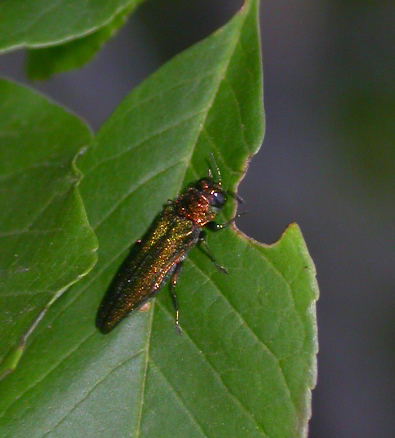Emerald ash borer confirmed in White County campground
By Jennifer Stewart
Ag Communications
September 1, 2006
 WEST LAFAYETTE, Ind. - Homeowners in White County need to be on the lookout for emerald ash borer, an Asian beetle that kills ash trees, after the Indiana Department of Natural Resources announced this week that an infestation had been confirmed in Monticello's Indiana Beach campground. WEST LAFAYETTE, Ind. - Homeowners in White County need to be on the lookout for emerald ash borer, an Asian beetle that kills ash trees, after the Indiana Department of Natural Resources announced this week that an infestation had been confirmed in Monticello's Indiana Beach campground.
First discovered near Detroit in 2002, emerald ash borer (EAB) has killed millions of ash trees in Michigan, Ohio and Indiana.
This latest infestation most likely arrived via firewood from Michigan, said Cliff Sadof, Purdue University entomologist.
"Campers from EAB-infested areas in Michigan, Ohio, Illinois and Indiana should leave their firewood at home," said Jodie Ellis, Purdue entomologist. "The situation in White County serves as yet another example of how EAB is spread to new sites through firewood."
Although emerald ash borer can still spread via firewood movement, the insects are more stationary now than they were during late spring and early summer months, which gives homeowners time to remove any dead ash trees and to develop a strategy for dealing with the beetle.
"Because the beetle is no longer flying, people will have time to plan a strategy," Sadof said. "Controls need not be applied before late April 2007."
Despite the fact that emerald ash borers are not currently flying, it is still important that homeowners survey their trees for the pests. Ash trees infested with the beetle will have a combination of symptoms, including dying leaves, shoots up the tree's trunk, increased woodpecker activity, vertical splits in the bark, tiny (1/8 inch) D-shaped exit holes on the trunk and limbs, and S-shaped tunnels under the bark.
If symptoms of an infestation are detected, homeowners should call the Indiana DNR's toll-free hotline for invasive species at 1-866-NO EXOTIC (1-866-663-9684). More information on identifying ash trees and emerald ash borer symptoms is available at a Purdue Web site .
"The long-term strategy is going to be a phasing out of the ash and phasing in of new tree species," Sadof said. "Pesticides can prolong the life of an ash tree, which will help keep shade on the property as replacement trees grow."
Although treatments are available and may extend tree life for a period of time, Ellis urges homeowners to only use them in appropriate situations.
"There are pesticides that can prolong the life of an individual ash tree, but they are only effective under certain conditions," Ellis said. "The ash tree has to be in good shape before starting treatment application, and treatments have to be applied at the right time, with the right method of application, every single year."
As for White County, the Indiana Beach campground's current emerald ash borer strategy includes slowing the beetle's spread with insecticides, removing dead trees as a safety measure, replacing dead trees and monitoring those trees that are still living, said grounds superintendent Steve Juntgen.
In addition to the campground strategy, the Department of Natural Resources will issue a quarantine, banning the movement of hardwood products out of White County. Following the quarantine will likely be a secondary quarantine of Union and Liberty townships that will ban the movement of hardwood products out of the townships.
Previous DNR strategies involved the removal of numerous ash trees as a preventative measure. This strategy has since been suspended. The Department of Natural Resources is currently working to educate the public about why it is important not to move firewood, what homeowners and landowners can do to protect their landscapes, and ways to deal with the insect once it is present.
Questions concerning emerald ash borer and the White County infestation should be directed to the DNR at (317) 232-4120 or to the Purdue entomology department by contacting Ellis at (765) 494-0822 or Sadof at (765) 494-5983.
Writer: Jennifer Stewart, (765) 494-8402, jsstewart@alumni.purdue.edu
Sources: Cliff Sadof, (765) 494-5983, csadof@purdue.edu
Jodie Ellis, (765) 494-0822, ellisj@purdue.edu
Steve Juntgen, (574) 583-1089
Ag Communications: (765) 494-2722;
Beth Forbes, forbes@purdue.edu
Agriculture News Page |